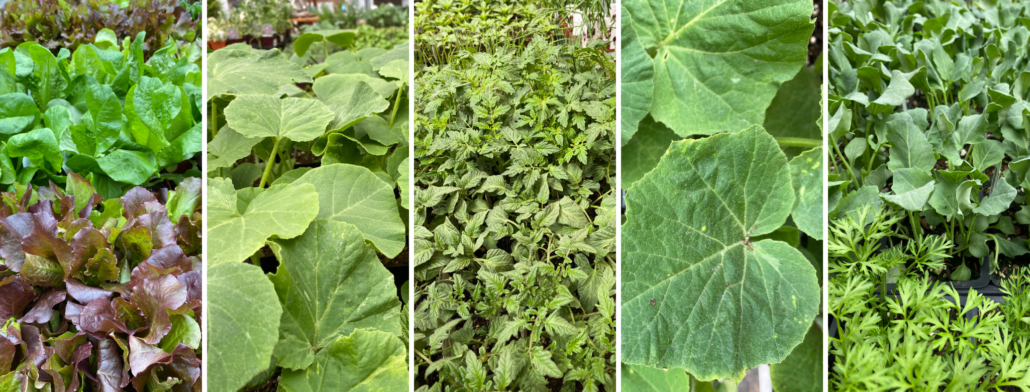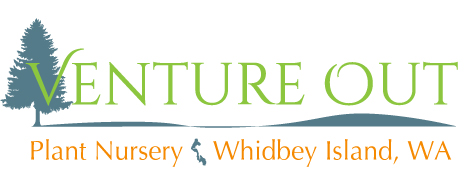Planting a Vegetable Garden in the Pacific Northwest

Here in the temperate Pacific Northwest, we have conditions favorable for a lot of great edible plants, but more challenging for others. We can grow cool season veggies like nobody’s business. Peas, lettuces, collards, kale, cabbage, broccoli, brussels sprouts, and the like are made for our weather. We struggle more with veggies that like heat or long growing seasons like tomatoes, corn, melons, and peppers, though they are not impossible, they just require more care and consideration.
Western Washington falls into USDA Hardiness Zones 6-9, so planting recommendations will vary a bit depending on where you are exactly. Here on Whidbey Island, we are in Zone 8b. You can find your Hardiness Zone HERE, this will come in handy for understanding which plants will do best for you and when to plant them based on the temperature range.
The very first thing you will need to do to plant an annual vegetable garden is make sure that you’ve got good soil ready to plant into. Here on Whidbey and much of the PNW we have either very sandy/rocky soil or hard clay soil. Either type will need a lot of amendments to grow vegetables, which generally require a rich, loamy, well-draining soil. If you want to try to make your native soil better, first get a soil test to tell you what you need to add to make it more hospitable. If you would rather avoid the work of building your native soil you can instead create raised beds or garden in pots or planters, using a pre-mixed soil for the purpose of gardening, such as G&B Organic Raised Bed soil. Even with pre-mixed soil you will still want to read up on what you’re planting, as some crops will need more fertility than others, and if you want to continue to use the same soil for many years there are considerations for that as well.
Once you have a place for your plants to live, you can begin to plan what to grow. It is easy to get excited and want to grow a little of everything, trust me! A good strategy for choosing vegetables and other food plants, is to go through your fridge and pantry and find out what it is that your family eats most or finds most enjoyable. It can be a balancing act as well, if you’re limited for space or time in the garden, you’ll have to find what works best for you. My family eats a ton of garlic, onions, leeks, and potatoes. I’ve found that while I can grow garlic and leeks really well, I am not as successful with onions or potatoes in the quantities we would need, so rather than eat up a lot of my garden space I buy onions and potatoes from local farmers who can grow them better and in greater quantities. I can grow zucchini and other squashes enough for our needs, so I prioritize those over broccoli or brussels sprouts, which we love but take up a lot of space and are harder for me to keep pest free. A couple of cherry tomato plants fit nicely into our space, but for my large tomato canning projects I don’t have the space to grow as many as I would need so I opt to buy those as well. Perhaps you have a hard-to-find vegetable or fruit that you love? Maybe you can grow it yourself! We are big fans of hardy kiwi and ground cherries, but these are rarely found at the market, so we grow them. Don’t be afraid to experiment, try out lots of things, some will work great, and some may not, but that will just make next year’s garden a more likely success.
Once you’ve chosen what you want to grow the question becomes, to grow from seed or get starts? I found personally that starts are a great way to get used to gardening, as they are more likely to grow well, and you’ll avoid the pitfalls of seed starting. There are some things that do better from seed, such as carrots, beets, and other root veggies, so if you’re up for the challenge of growing from seed these would be a good place to start. Things like peas and beans do great as well. Some things, like tomatoes, peppers, and melons, which require an early start and a long growing season will have to be transplanted into the garden no matter what, so buying starts is the easiest way to go. But again, if you’re up for the challenge you can read up on starting your own seeds indoors in trays or pots. We’ve got a Video to help you too!
When to plant is the next question that arises. You will need to know the first and last Frost Dates for your region (find yours HERE). Once you know these dates you can plan when you can start planting and calculate when is the latest you can plant based on the length of time your chosen plant takes to grow and ripen. On seed packets or plant labels you’ll see when the best times are to plant them based on frost dates or just a range of dates. For starts you want the “transplant outside” date as opposed to seed starting date. Here is a great Planting Calendar for the PNW from Deep Harvest Farm right here on Whidbey. If you’re unsure, asking local Master Gardeners, nursery staff, or farmers can be helpful. There are lots of groups out there to help gardeners, people love helping others get into gardening!
Finally, you’re ready to plant! Having a few tools such as a small hand shovel, a hori hori, a larger shovel for bigger plants, a garden fork, gloves and a stool or knee pads can be helpful. Most gardeners have their favorites, my trusty garden fork is a go-to for me, as well as the hori hori. Follow instructions for each plant or seed, depth of planting as well as watering are important. Be ready to water regularly throughout the growing season, annual veggies especially need regular water, but not too much, and benefit from soaker hoses or ground level watering if possible, to avoid wetting the plants themselves. The cool, moist PNW weather is a recipe for fungal growth, so giving plants space for airflow and keeping them from getting too wet is important for plant health. Investing in a well-placed, good quality irrigation system can be a huge time saver as well as help to keep plants at their best.
Once your plants are in the ground it’s a matter of keeping them watered, well fed with fertilizer as needed, protecting from pests, and watching for potential health problems. If you’re like me, you’ll check on your little plant babies every day, watching them grow and change. Catching things early is best, so while visiting be sure to watch for pest nibbles, droppings, bugs or slug trails, yellowing or wilting leaves, fuzzy white or grey film, spots or anything that seems abnormal and then treat as necessary. There are lots of strategies for dealing with garden troubles but having an Integrated Pest Management plan can help to address them. WSU has a couple of pages dedicated to helping home gardeners manage common pests. Check out Hortsense for plant problems and weeds, and Pestsense for common indoor pests. Growing your own food at home can be challenging and rewarding. You’ll be getting fresh air, exercise, hands in the dirt, connecting with nature, and eventually fresh, healthy food. For some of you perhaps, this could be the beginning of a lifelong passion. We at Venture Out are here to help you along the way, with tools, plants, seeds, soil, fertilizers, education and advice – Happy Gardening!
If you’d like to start your own seeds in a greenhouse or sunny window, check out this video with Tobey Nelson for detailed instructions!
